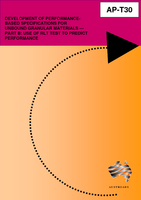Pavement

Development of Performance-based Specifications for Unbound Granular Materials Part B: Use of RLT Test to Predict Performance
- Publication no: AP-T30-03
- ISBN: 0 85588 679 X
- Published: 1 December 2003
- PDF (free) Download
The Austroads Member Authorities (AMAs) are developing a Performance Based Specification (PBS) approach to the specification of unbound granular materials in Australia and New Zealand. There has been general agreement to adopt the engineering properties related to workability and performance for PBS of granular pavement layers. This report reviews the RLT testing equipment and test procedures in terms of the requirements of a practical commercial test, test protocols for determination of stress dependent characteristics of permanent strain and resilient modulus of unbound pavement materials, and limitations of the test. It also assesses the use of derived indices from the test method to determine specification limits. There has also been consensus among AMAs on the use of repeated load triaxial (RLT) test as the best candidate laboratory performance test to pursue new material performance measures (such as shear strength, resilient modulus and pavement layer deformation). It can be used to modify existing specification to introduce performance related characteristics for unbound granular pavement materials which allow the relaxation of generally stringent manufacturing parameters by incorporating mix design options to meet specified performance characteristics. This approach will permit source materials to include reclaimed demolition concrete, industrial slag and mine waste from which the mix design can be compared with mix properties using granular materials manufactured through traditional material specifications. Currently, there is insufficient laboratory RLT and field performance data to validate the performance models for determination of the specification limits for this test. There is no consensus in using either drained or undrained conditions, and in using either relative moisture content or degree of saturation as well as the compaction levels, in the RLT test, to replicate actual field conditions in terms of moisture content and density var
- DEVELOPMENT OF PERFORMANCE-BASED SPECIFICATIONS FOR UNBOUND GRANULAR MATERIALS — PART B: USE OF RLT TEST TO PREDICT PERFORMANCE
- AUSTROADS PROFILE
- AUSTROADS MEMBERSHIP
- EXECUTIVE SUMMARY
- TABLE OF CONTENTS
- 1. SCOPE
- 2. CONTEXT
- 3. DEVELOPMENT OF PERFORMANCE-BASED MATERIAL SPECIFICATIONS
- 4. CAPABILITY OF STANDARD RLT TEST METHODS
- 5. PROCEDURES FOR DETERMINATION OF RLT PERFORMANCE INDICES AND SPECIFICATION LIMITS
- 6. RELAXATION OF ‘EMPIRICAL COMPONENT’ IN ‘RECIPE-BASED’ MATERIAL SPECIFICATIONS
- APPENDIX A: STANDARD RLT TEST METHODS
- APPENDIX B: DATA SOURCES FOR PREDICTION FIELD COMPACTION AND MOISTURE CONDITIONS
- BIBLIOGRAPHY
- INFORMATION RETRIEVAL
Related publications
Latest Pavement News
